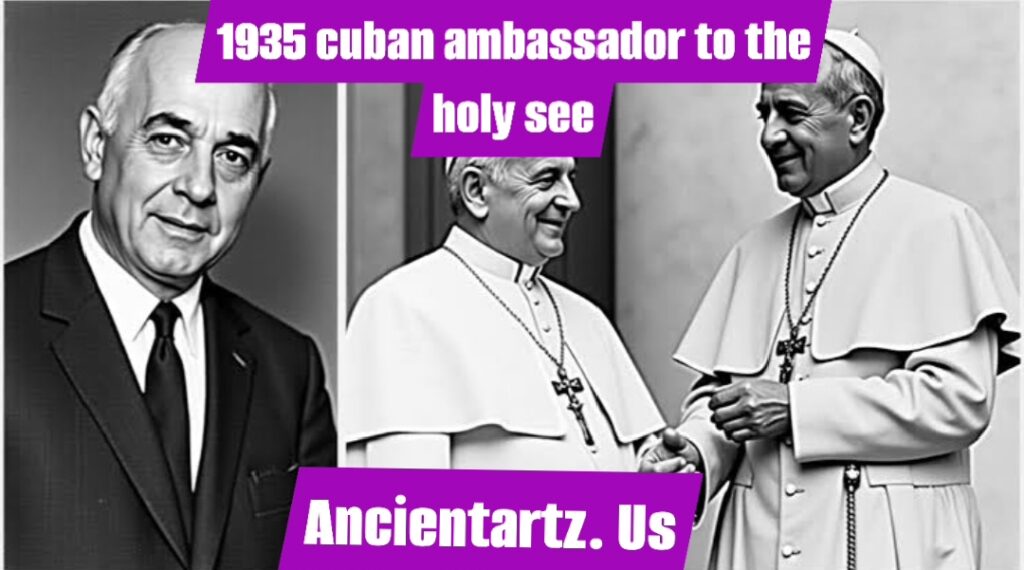INTRODUCTION
The relationship between Cuba and the Vatican has always been a topic of great historical significance, reflecting the broader interactions between the Catholic Church and Latin American nations. One of the most pivotal moments in this relationship occurred in 1935 when Cuba appointed its ambassador to the Holy See. This event was not merely a political appointment but a deeply symbolic and strategic move, representing the island nation’s alignment with the Vatican’s moral and spiritual authority. Understanding the context of this appointment requires an exploration of the historical, political, and religious backdrop that shaped Cuba’s decision to establish a stronger presence in the Vatican during this period. The 1930s was a time of political turbulence and ideological shifts across the world, and for Cuba, a nation with strong Catholic roots, formalizing diplomatic ties with the Holy See carried both national and international significance. This article will delve into the various aspects of this historic appointment, exploring the background, the significance, the role of the ambassador, the impact on Cuban-Vatican relations, and the broader implications of this diplomatic move.
THE HISTORICAL BACKGROUND LEADING TO THE 1935 APPOINTMENT
The appointment of 1935 cuban ambassador to the holy see did not occur in isolation. It was the result of years of evolving relations between Cuba and the Vatican, influenced by the broader political and religious landscape of the time. Since its independence from Spain in 1898, Cuba had undergone significant political transformations, with periods of instability and reforms shaping its diplomatic strategies. The Catholic Church had maintained a strong influence over Cuban society, with the majority of the population adhering to Catholicism. The Vatican, recognizing Cuba’s strategic importance in Latin America, had always sought to strengthen its religious presence on the island. By 1935, Cuba was under the leadership of President Carlos Mendieta, who sought to stabilize the nation through diplomatic engagements. The decision to appoint an ambassador to the Holy See was a reflection of this broader goal, emphasizing the nation’s commitment to Catholic values while seeking moral and diplomatic support from the Vatican.
SIGNIFICANCE OF THE DIPLOMATIC RELATIONSHIP BETWEEN CUBA AND THE HOLY SEE
1935 cuban ambassador to the holy see decision to establish a formal diplomatic mission to the Vatican was significant for several reasons. First, it reinforced the island’s cultural and religious ties with Catholicism, which had been a cornerstone of Cuban society since the colonial era. The Catholic Church played a crucial role in education, social services, and moral guidance, making its influence deeply ingrained in the Cuban way of life. Second, the appointment of an ambassador to the Holy See signaled Cuba’s intention to strengthen its position on the international stage. At a time when global politics were shifting dramatically, having formal representation at the Vatican was a way to enhance Cuba’s diplomatic credibility. Third, the move was also a strategic response to the ideological battles of the time. With the rise of communism and fascism in Europe, many Latin American nations, including Cuba, sought to reaffirm their alignment with traditional institutions like the Catholic Church to counteract these emerging threats. The Vatican, as a moral authority, provided a stabilizing influence that Cuban leaders deemed essential for national unity.
ROLE OF THE 1935 CUBAN AMBASSADOR TO THE HOLY SEE
The individual appointed as Cuba’s ambassador to the Vatican in 1935 had a significant role to play in fostering diplomatic relations between the two entities. This position was not merely ceremonial; it required deep engagement with Vatican officials, participation in discussions on religious and political matters, and the representation of Cuban interests at the Holy See. The ambassador acted as a bridge between the Cuban government and the Vatican, ensuring that both parties maintained a positive and cooperative relationship. One of the key responsibilities was to advocate for the Catholic Church’s role in Cuban society, particularly in areas such as education and social welfare. Additionally, the ambassador was tasked with communicating Cuba’s political stance on various international issues, ensuring that the Vatican remained informed about the nation’s policies and perspectives. This role required diplomatic finesse, as the ambassador had to navigate complex political and religious landscapes while maintaining a balance between national interests and Vatican expectations.
IMPACT OF THE 1935 APPOINTMENT ON CUBAN-VATICAN RELATIONS
The appointment of 1935 cuban ambassador to the holy see had a profound impact on the relationship between the two entities. One of the immediate effects was the strengthening of diplomatic ties, leading to increased collaboration on religious and social issues. The Vatican played a crucial role in shaping educational policies in Cuba, and the presence of an ambassador facilitated more direct communication and cooperation in this area. Furthermore, the appointment reinforced Cuba’s identity as a predominantly Catholic nation, helping to solidify the Church’s influence in national affairs. Beyond the domestic impact, the move also enhanced Cuba’s international reputation. Establishing a formal diplomatic mission to the Vatican signaled to the world that Cuba was committed to maintaining strong ties with influential global institutions. This was particularly important during a time when the international political landscape was becoming increasingly polarized. By aligning itself with the Vatican, Cuba positioned itself as a nation that valued moral and spiritual guidance, an image that proved beneficial in diplomatic circles.
BROADER IMPLICATIONS OF CUBA’S DIPLOMATIC ENGAGEMENT WITH THE HOLY SEE
The decision to appoint an ambassador to the Vatican in 1935 was not just a diplomatic maneuver; it had broader implications for Cuba’s political, social, and religious landscape. One of the key implications was the reinforcement of Catholic values in Cuban society. The Church had always played a significant role in shaping the nation’s moral framework, and the establishment of a formal diplomatic relationship with the Vatican further solidified this influence. Additionally, the move had economic and political implications. By strengthening ties with the Vatican, Cuba was able to engage with other Catholic-majority nations, facilitating trade and diplomatic cooperation. Furthermore, the decision reflected the Cuban government’s recognition of the Vatican as a key player in global affairs. The Holy See had a unique position in international diplomacy, serving as a neutral mediator in conflicts and a moral authority on various issues. By establishing formal representation, Cuba gained access to this influential network, enhancing its diplomatic reach.
CONCLUSION
The appointment of 1935 cuban ambassador to the holy see was a historic moment that underscored the island nation’s commitment to its Catholic heritage and its desire to strengthen diplomatic ties with the Vatican. This move was not just about political symbolism; it had tangible effects on Cuban society, influencing education, social policies, and international relations. The relationship between Cuba and the Vatican continued to evolve over the years, with the 1935 appointment serving as a foundation for future engagements. The presence of an ambassador facilitated better communication, ensuring that both parties could collaborate effectively on various issues. Furthermore, the move reinforced Cuba’s position on the international stage, aligning it with one of the most influential religious institutions in the world. Looking back, the appointment was a strategic decision that helped shape Cuba’s diplomatic trajectory, leaving a lasting impact on its relations with the Vatican.
FREQUENTLY ASKED QUESTIONS (FAQS)
1. Why was the appointment of Cuba’s ambassador to the Holy See in 1935 significant? The appointment was significant because it strengthened Cuba’s diplomatic ties with the Vatican, reinforced the Catholic Church’s influence in Cuban society, and enhanced Cuba’s international standing.
2. How did the 1935 appointment affect Cuba’s relationship with the Vatican? It led to increased cooperation on religious, educational, and social issues, improving communication and collaboration between the two entities.
3. What role did the ambassador play in Cuban-Vatican relations? The ambassador acted as a bridge between the Cuban government and the Vatican, advocating for Catholic interests in Cuba while representing Cuba’s political and diplomatic positions at the Holy See.
4. Did the appointment have any long-term effects on Cuba’s diplomatic strategies? Yes, it laid the groundwork for continued diplomatic engagements with the Vatican and reinforced Cuba’s commitment to maintaining strong ties with influential global institutions.
5. How did the Catholic Church benefit from the appointment? The Church gained greater influence in Cuban society, particularly in areas such as education and social services, ensuring its continued role in shaping national policies.
Also Read This: THE 1935 CUBAN AMBASSADOR TO THE HOLY SEE: A HISTORIC DIPLOMATIC MISSION



